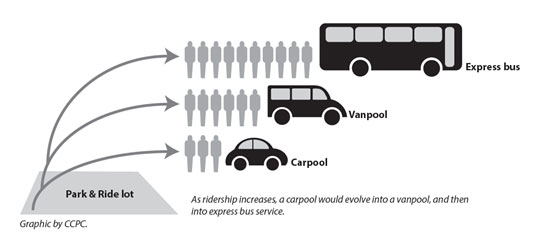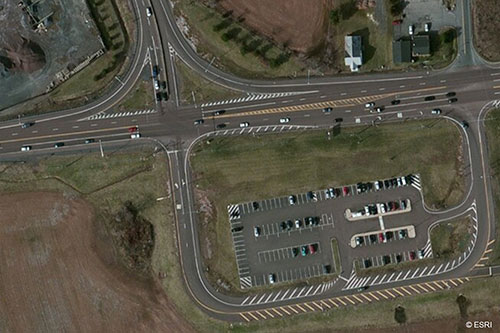Park and Rides
Park and Ride
Parking lots designed to allow vehicle owners to park at a common site and maximize the use of public transit, vanpools and carpools.
A park and ride facility offers a safe, convenient location for commuters to leave their automobiles and travel to their destination in carpools, vanpools or buses. Park and ride facilities reduce the total number of vehicle miles of travel and improve air quality. A park and ride facility can offer a transit provider convenient access to a large number of patrons without going to the added operating expense and time of circulating buses through residential neighborhoods.
Park and ride lots can provide the following benefits:
- Improves Energy Efficiency: Park and ride lots can lead to reductions in vehicle miles of travel, energy consumption and vehicle emissions.
- Encourages Public Transit Opportunities: While many communities would like to establish some form of public transportation for their residents and commuters, few municipalities have the development density to financially support public transportation. A heavily used park and ride lot can create a critical mass that may lead to the development or extension of a bus route. Decisions about routes are made in the context of available funding and, in SEPTA's case, as part of its established Services Standards and Process and Annual Service Plan.
- Reduces Congestion: As major highways are reconstructed, congestion can be mitigated through the expansion of ridesharing, which is further enabled with the provision of Park and Ride lots.
Park and ride facilities may range in scope from several reserved parking spaces within a commercial or institutional parking lot to a facility of 500 or more parking spaces. The facilities may include:
- bus loading and unloading areas;
- taxi or kiss-and-ride areas;
- bicycle parking; and
- ADA compliant pedestrian access.
The size of the parking lot is dependent on the design volume, the available land area, and the size and number of other parking lots in the area.
Park and ride lots come in different forms including:
- A parking lot that was constructed for other uses such as a shopping mall but is being informally used for ride sharing.
- A parking lot at a shopping center or church which has been formally leased for use by commuters; or,
- A lot which has been constructed by a public agency exclusively for use by commuters.
Chester County's recently adopted Public Transportation Plan recommends implementation of the 'New Commuter Service Model' to address not only roadway congestion, but also service gaps and new service requests in the existing public transportation system. These new commuter services would begin as: a carpool originating from one of the park & ride locations; a group of people working at one of the county's major employment centers; or, any combination thereof. As the numbers of riders/participants increase, carpools would then evolve into a vanpool, and eventually into an express bus service.

Recommendations
Develop additional park and rides within Chester County. There are seven existing park & ride facilities located near major interchanges throughout the county as represented by letters a-g on the exhibit below.

Proposed facilities (as indicated by letters h-q) in the exhibit above should be developed through the land development process and/or shared use arrangements with existing commercial centers.
Similar to bus shelters, the maintenance of park & ride lots is an existing barrier to the expansion of these facilities. Presently, PennDOT will develop park and ride lots but is reluctant to accept the maintenance responsibilities. Resolution of this issue is critical to the expansion of the park & ride network as envisioned by the Public Transportation Plan.
Considerations for new park and rides include:
- Park and ride lots must be designed with safe access into and out of the lot.
- Locate park-and-ride lots adjacent to major highways interchanges and/or adjacent to existing or anticipated bus routes and visible to commuters whom they are intended to attract. In all cases, directional and informational signage should be provided. The parking areas should be located at points that precede bottlenecks or significant traffic congestion and close to residential areas to minimize single occupant vehicle traffic.
- Appropriate landscaping should be provided to mitigate the aesthetics associated with parking areas. The landscaping design should avoid unsightly expanses of pavement and should consider security as well as sight distance requirements. See also the LANDSCAPE MATERIAL design element.
- Street lighting should be included in the design of the project where security issues may be present. See also the LIGHTING design element.
- New facilities should provide adequate turning radii for both a standard 40 foot bus and a coach bus. See also the VEHICLE CHARACTERISTICS design element.
- Porous paving should be considered for lot surfacing to reduce stormwater runoff.
- Municipalities should consider encouraging the dedication of spaces for park and ride in commercial uses during the land development process. For example, a cinema complex may be an excellent opportunity for day use as a park and ride lot.
- A promotional program is needed periodically to inform the public of the availability of the lot.
- Park-and-ride facilities could be provided through lease arrangement with existing commercial properties, churches or fire halls. The reason for leasing space instead of building a new facility is to reduce the initial cost, assess the demand for such a facility and minimize the potential depletion of existing land.
- When demand at an existing, leased facility increases it may require leasing more parking spaces, making an addition to the existing facility or building an entirely new facility.
- Development of a park and ride facility should include a maintenance agreement that should be codified as an obligation of the land developer/property owner through the land development process.
References
- AASHTO Guide for Park-and-Ride Facilities, 2nd Edition
- Park-and-Ride Planning and Design Guidelines, Robert J. Spillar, P.E., Lead Transportation Engineer, Parsons Brinckerhoff Quade & Douglas, Inc., October 1997



